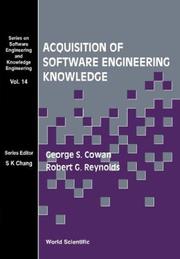| Listing 1 - 9 of 9 |
Sort by
|
Book
ISBN: 3319741713 3319741691 Year: 2018 Publisher: Cham : Springer International Publishing : Imprint: Springer,
Abstract | Keywords | Export | Availability | Bookmark
 Loading...
Loading...Choose an application
- Reference Manager
- EndNote
- RefWorks (Direct export to RefWorks)
The author first introduces the basic framework for cultural algorithms and he then explains the social structure of a cultural system as a mechanism for the distribution of problem-solving information throughout a population. Three different models for social organizations are presented: the homogeneous (nuclear family), heterogeneous (expanded family), and subculture (descent groups) social models. The chapters that follow compare the learning capabilities of these social organizations relative to problems of varying complexity. The book concludes with a discussion of how the results can impact our understanding of social evolution.
Computer science. --- Artificial intelligence. --- Application software. --- Computational intelligence. --- Computer Science. --- Artificial Intelligence (incl. Robotics). --- Computational Intelligence. --- Computer Appl. in Social and Behavioral Sciences. --- Computational Social Sciences. --- Intelligence, Computational --- Artificial intelligence --- Soft computing --- Application computer programs --- Application computer software --- Applications software --- Apps (Computer software) --- Computer software --- AI (Artificial intelligence) --- Artificial thinking --- Electronic brains --- Intellectronics --- Intelligence, Artificial --- Intelligent machines --- Machine intelligence --- Thinking, Artificial --- Bionics --- Cognitive science --- Digital computer simulation --- Electronic data processing --- Logic machines --- Machine theory --- Self-organizing systems --- Simulation methods --- Fifth generation computers --- Neural computers --- Informatics --- Science --- Social intelligence. --- Intelligence, Social --- Intellect --- Social psychology --- Engineering. --- Social sciences --- Social sciences—Data processing. --- Social sciences—Computer programs. --- Artificial Intelligence. --- Data processing. --- Construction --- Industrial arts --- Technology
Digital
ISBN: 9783319741710 Year: 2018 Publisher: Cham Springer International Publishing
Abstract | Keywords | Export | Availability | Bookmark
 Loading...
Loading...Choose an application
- Reference Manager
- EndNote
- RefWorks (Direct export to RefWorks)
The author first introduces the basic framework for cultural algorithms and he then explains the social structure of a cultural system as a mechanism for the distribution of problem-solving information throughout a population. Three different models for social organizations are presented: the homogeneous (nuclear family), heterogeneous (expanded family), and subculture (descent groups) social models. The chapters that follow compare the learning capabilities of these social organizations relative to problems of varying complexity. The book concludes with a discussion of how the results can impact our understanding of social evolution.
Social sciences (general) --- Sociology --- Demography --- Social sciences --- Applied physical engineering --- Computer architecture. Operating systems --- Information systems --- Artificial intelligence. Robotics. Simulation. Graphics --- Computer. Automation --- neuronale netwerken --- fuzzy logic --- cybernetica --- analytische chemie --- biochemie --- informatica --- sociale wetenschappen --- computerprogramma's --- KI (kunstmatige intelligentie) --- ingenieurswetenschappen --- gegevensverwerking --- AI (artificiële intelligentie)

ISBN: 1281933910 9786611933913 9812791396 9789812791399 9810229208 9789810229207 Year: 2003 Publisher: River Edge, N.J. : World Scientific,
Abstract | Keywords | Export | Availability | Bookmark
 Loading...
Loading...Choose an application
- Reference Manager
- EndNote
- RefWorks (Direct export to RefWorks)
This is the first book that attempts to provide a framework in which to embed an automatic programming system based on evolutionary learning (genetic programming) into a traditional software engineering environment. As such, it looks at how traditional software engineering knowledge can be integrated with an evolutionary programming process in a symbiotic way.
Computer software --- Genetic programming (Computer science) --- Computer programming --- Genetic algorithms --- Evaluation. --- Quality control.

ISBN: 0122598369 0122598350 Year: 1989 Publisher: San Diego : Academic Press,
Abstract | Keywords | Export | Availability | Bookmark
 Loading...
Loading...Choose an application
- Reference Manager
- EndNote
- RefWorks (Direct export to RefWorks)
Llamas --- Indians of South America --- Lama (Mammifère) --- Indiens d'Amérique --- Domestic animals --- Animaux domestiques
Book
ISBN: 1315418517 1315418525 1315418533 159874772X 9781598747720 Year: 2009 Publisher: Walnut Creek, Calif. : Left Coast Press,
Abstract | Keywords | Export | Availability | Bookmark
 Loading...
Loading...Choose an application
- Reference Manager
- EndNote
- RefWorks (Direct export to RefWorks)
In this volume, the authors present an original ethnographic study of five llama herding communities in Ayacucho, Peru. Data on herd dynamics are subjected to computer modeling in an effort to evaluate the roles of biology, symbolic and ritual behavior, ecological adaptation, and practical reason. The book contains the most detailed study of the waytakuy llama marking ceremony yet available. The role of this ceremony in preventing herds from going to extinction is evaluated against anthropological and sociobiological theory. This is an interdisciplinary book will appeal to professional ar
Wamani Indians --- Llamas --- Indians of South America --- Domestic animals. --- Domestic animals --- Antiquities. --- Ayacucho (Peru : Dept.) --- Peru
Book
ISBN: 354062788X 3540685189 Year: 1997 Volume: 1213 Publisher: Berlin [etc.] : Springer-Verlag,
Abstract | Keywords | Export | Availability | Bookmark
 Loading...
Loading...Choose an application
- Reference Manager
- EndNote
- RefWorks (Direct export to RefWorks)
This book constitutes the refereed proceedings of the 6th International Conference on Evolutionary Programming, EP 97, held in Indianapolis, IN, USA, in April 1997. The 36 revised full papers presented were carefully selected for inclusion in the proceedings. The papers are organized in sections on evolutionary methods for modeling and training, alternative frameworks for the computational study of evolutionary social systems, genetic programming: issues and applications, issues in evolutionary optimization, enhanced evolutionary operators, theory and analysis of evolutionary computations, issues in adaptability: theory and practice, and evolution and NP-hard problems.
Evolutionary programming (Computer science) --- Computer Science --- Engineering & Applied Sciences --- Congresses --- Computer science. --- Computer communication systems. --- Computer programming. --- Computers. --- Algorithms. --- Artificial intelligence. --- Computer simulation. --- Computer Science. --- Simulation and Modeling. --- Artificial Intelligence (incl. Robotics). --- Programming Techniques. --- Computation by Abstract Devices. --- Algorithm Analysis and Problem Complexity. --- Computer Communication Networks. --- Computer software. --- Artificial Intelligence. --- Computer modeling --- Computer models --- Modeling, Computer --- Models, Computer --- Simulation, Computer --- Electromechanical analogies --- Mathematical models --- Simulation methods --- Model-integrated computing --- Informatics --- Science --- Software, Computer --- Computer systems --- AI (Artificial intelligence) --- Artificial thinking --- Electronic brains --- Intellectronics --- Intelligence, Artificial --- Intelligent machines --- Machine intelligence --- Thinking, Artificial --- Bionics --- Cognitive science --- Digital computer simulation --- Electronic data processing --- Logic machines --- Machine theory --- Self-organizing systems --- Fifth generation computers --- Neural computers --- Communication systems, Computer --- Computer communication systems --- Data networks, Computer --- ECNs (Electronic communication networks) --- Electronic communication networks --- Networks, Computer --- Teleprocessing networks --- Data transmission systems --- Digital communications --- Electronic systems --- Information networks --- Telecommunication --- Cyberinfrastructure --- Network computers --- Algorism --- Algebra --- Arithmetic --- Automatic computers --- Automatic data processors --- Computer hardware --- Computing machines (Computers) --- Electronic calculating-machines --- Electronic computers --- Hardware, Computer --- Cybernetics --- Calculators --- Cyberspace --- Computers --- Electronic computer programming --- Electronic digital computers --- Programming (Electronic computers) --- Coding theory --- Distributed processing --- Foundations --- Programming

ISBN: 0915703599 9780915703593 Year: 2005 Volume: 40 v. 13 Publisher: Ann Arbor: University of Michigan. Museum of anthropology,
Abstract | Keywords | Export | Availability | Bookmark
 Loading...
Loading...Choose an application
- Reference Manager
- EndNote
- RefWorks (Direct export to RefWorks)
Indians of Mexico --- Indian pottery --- Excavations (Archaeology) --- San José Mogote (Mexico) --- Antiquities. --- San José Mogote (Mexico)
Book
ISBN: 9780262290920 9780262133173 0262133172 0262290928 0585038473 Year: 1995 Publisher: Cambridge, Massachusetts [Piscataqay, New Jersey] MIT Press IEEE Xplore
Abstract | Keywords | Export | Availability | Bookmark
 Loading...
Loading...Choose an application
- Reference Manager
- EndNote
- RefWorks (Direct export to RefWorks)
March 1-3, 1995, San Diego, California Evolutionary programming is one of the predominate algorithms withing the rapidly expanding field of evolutionary computation. These edited contributions to the Fourth Annual Conference on Evolutionary Programming are by leading scientists from academia, industry, and defense. The papers describe both the theory and practical application of evolutionary programming, as well as other methods of evolutionary computation including evolution strategies, genetic algorithms, genetic programming, and cultural algorithms.Topics include :- Novel Areas of Evolutionary Programming and Evolution Strategies.- Evolutionary Computation with Medical Applications.- Issues in Evolutionary Optimization Pattern Discovery, Pattern Recognition, and System Identification.- Hierarchical Levels of Learning.- Self-Adaptation in Evolutionary Computation.- Morphogenic Evolutionary Computation.- Issues in Evolutionary Optimization.- Evolutionary Applications to VLSI and Part Placement.- Applications of Evolutionary Computation to Biology and Biochemistry Control.- Applications of Evolutionary Computation.- Genetic and Inductive Logic Programming.- Genetic Neural Networks.- The Future of Evolutionary Computation.A Bradford Book. Complex Adaptive Systems series.
Book

ISBN: 0915703947 Year: 2019 Publisher: Ann Arbor, Michigan : Museum of Anthropology, University of Michigan,
Abstract | Keywords | Export | Availability | Bookmark
 Loading...
Loading...Choose an application
- Reference Manager
- EndNote
- RefWorks (Direct export to RefWorks)
Indians of Mexico --- Excavations (Archaeology) --- Indians of Mexico --- Excavations (Archaeology) --- Mixtec Indians --- Zapotec Indians --- Antiquities. --- Antiquities. --- Antiquities. --- Antiquities. --- Oaxaca Valley (Mexico) --- Oaxaca Valley (Mexico) --- San José Mogote (Mexico) --- Mexico --- Mexico --- Antiquities. --- Social life and customs. --- Antiquities.
| Listing 1 - 9 of 9 |
Sort by
|

 Search
Search Feedback
Feedback About UniCat
About UniCat  Help
Help News
News